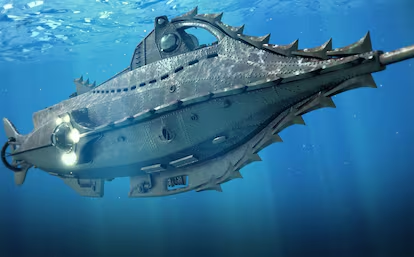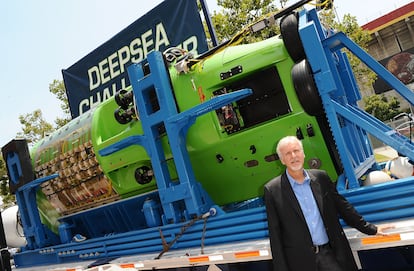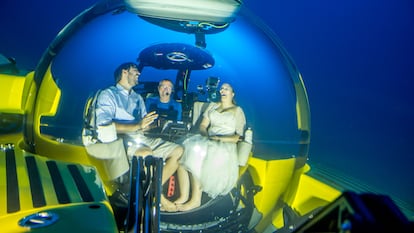Are submersible super-yachts the next adventure for billionaire tourists?
A project led by James Cameron to promote deep-sea tourism aspires to more than entertaining the ultra-wealthy


Ray Dalio has sometimes been compared to Captain Nemo, the unforgettable fictional character from two Jules Verne novels: 20,000 Leagues Under the Sea (1870) and The Mysterious Island (1875). He was an Indian prince and engineer who roamed the seas at the helm of the Nautilus, a submarine described by Verne as “a masterpiece full of masterpieces.” Nemo has appeared in various film adaptations of Verne’s novels, where he has been portrayed by famous actors like James Mason and Michael Caine. A collector of coral, pearls and Renaissance paintings, the captain was a connoisseur and an outlaw, an anti-establishment rebel and a vigilante of the seas. One day he would rescue shipwrecked sailors and defend hard-working Pacific islanders, and the next he would sink ships without thinking twice.
Any similarities between the fictional Nemo and the real-life Dalio are purely coincidental, of course. Dalio is a New Yorker who grew up in Queens, the same New York City borough that produced Donald Trump. He is not an aristocrat or a scientist, but a very successful money manager who founded in 1975 what is now Bridgewater Associates, a multinational venture capital firm.
Nemo and Dalio are immensely rich philanthropists who abhor ostentation and love the underwater world. In a phrase that Nemo could have uttered, Dalio once said that Elon Musk’s plans for space tourism to the Moon and Mars are “a foolish project that holds little interest.” But traveling to the bottom of the sea is indeed worthwhile. “That is where true wonders and real aliens await us.”
The budding submersible yacht industry
In December 2022, Dalio jumped into the luxury recreational diving business when he invested in Triton, the world’s largest manufacturer of civilian submersibles. Co-founded by Patrick Lahey, the company needed investment partners to make and sell submarines that can take ordinary (but rich) people on luxury cruises to unusual places like the Mariana Trench, the world’s deepest oceanic depression. Lahey found two investors to take the plunge — Ray Dalio and filmmaker James Cameron.

Cameron, who made a fortune from huge blockbuster movies like Avatar (2009), Titanic (1997) and Terminator (1984), says his investment in Triton was primarily motivated by the scientific objectives of the new business venture. He believes that private fleets of luxury submarines will enable us “to better understand the 80% of the world’s oceans that are still unexplored.”
Triton’s vessels are equipped with highly advanced imaging systems powered by artificial intelligence that store everything they capture in the audiovisual archive of the human race. In a brief interview with The Financial Times, Dalio said, “If you’re just going on a yacht in some fancy place, that’s one thing. If instead you’re on a yacht and you can go down and explore, first of all the trip is going to be better and also it encourages exploration.”
Look but don’t touch
These underwater adventures aren’t for everyone. Triton submersibles start at $2.5 million and range all the way up to more than $40 million. The base models can only dive to depths of a few hundred yards and can accommodate a maximum of 10 people. The top-of-the-line models are submersible super-yachts that can accommodate 66 guests. The most sophisticated Triton vessels can descend all the way to the bottom of the Mariana Trench in the western Pacific Ocean.

Triton’s website describes its vessels as works of “superlative” engineering intended for “demanding professionals and discerning individuals.” They are built “with the best materials” and equipped with “excellent visibility” due to their “optically perfect” acrylic windows that ensure “a direct and intimate relationship with the depths of the sea.”
Francesca Webster, editor of Super Yacht Times, describes the project as an exciting partnership with “elite collaborators” like Espen Øino, the Monaco-based yacht designer that recently created a futuristic submersible prototype called Project Hercules. Webster called the personal submarine project, “… not just as a toy for the super rich – but a viable tool that can advance human understanding and excitement for the ocean.”
Strange creatures at the bottom of the sea
There are no Johnny-come-latelys in this initiative. Over 30 years ago, James Cameron made The Abyss (1989), a classic science fiction film about a U.S. nuclear submarine’s encounter with an unidentified object in the Cayman Trough. The message was that we are living right next door to unknown worlds in the ocean depths, and that exploring these worlds is the human race’s immediate destiny.
On March 26, 2012, James Cameron proved that he takes his passions very seriously by making a solo descent to 35,787 feet (10,908 meters), give or take a foot, aboard the Deepsea Challenger. It was the first solo dive and only the second crewed dive to reach the deepest point on the planet after oceanographers Jacques Picard and John Walsh made their 1960 descent in the Trieste bathyscaphe.

Shortly after his historic descent, Cameron gave a speech at the annual meeting of the American Geophysical Union in San Francisco in which he described finding new species of marine worms and sea anemones in the previously unknown New Britain Trench near Papua New Guinea. But the vessel Cameron used over 10 years ago is nothing like the submersible venues that Triton envisions. Back then, Cameron spent nine claustrophobic hours in a tiny cabin measuring just over 35 cubic feet (one cubic meter). “I had to do yoga for six months to become flexible enough to fit in there,” he said.
Oil exploration
Dalio also has some very strong credentials in ocean exploration. In 2016, with a personal fortune of more than $21 billion, the tycoon bought an old oil rig and converted it into a mobile scientific exploration and research center that he named the OceanXplorer. The size of a football stadium and equipped with state-of-the-art technology, the offshore station became the first venture of OceanX, a company that Dalio owns and manages with the youngest of his four sons, Mark.
In his 2017 memoir, Principles: Life and Work, Dalio calls OceanX the crown jewel of his philanthropic work because its mission is to produce knowledge and share it with the world. He also writes that ocean exploration is far more urgent, exciting and necessary than space conquest. In 2018, Mark Dalio persuaded James Cameron to invest in OceanX, which began a partnership that led to the recent investment in Triton.
Patrick Lahey is an engineer and entrepreneur who has been diving since 1975, and says he has contributed to the design of more than 50 manned submersibles. In 2007, Lahey and Steve Jones founded Triton Submarines to build and sell personal submersibles to yacht owners. The company received a boost in 2015 when British scientist and documentary filmmaker David Attenborough rented a Triton vessel to film the second season of the Blue Planet television series on Australia’s Great Barrier Reef.
Monturiol’s shadow
A few years later, Triton, now a thriving business based in Florida that was making five submarines a year, went to the small town of Sant Cugat near Barcelona to start a project inspired by Narcís Monturiol, the 19th-century Spanish inventor and pioneer of underwater navigation. Working closely with Barcelona-based Clúster Nàutic and the Polytechnic University of Catalonia, Triton and its partners are creating submersible prototypes capable of withstanding the low temperatures and high pressures found at the deepest places in the oceans.
Lahey is enjoying the growing popularity of underwater exploration by tourists and is setting his sights next on exploring the Arctic Ocean. He laughs amiably about those who called his idea “inconsistent and ridiculous.” Dalio, Cameron and Lahey feel like the heirs to the dreams and aspirations of those who came before, like Jacques Cousteau and Jules Verne. They will never attack warships with battering rams like Captain Nemo, but they share his thirst for knowledge and adventure, and have added a healthy dose of entrepreneurial pragmatism.
Dalio sums it up in one inspirational sentence. “Yachts aren’t all about opulence… They’re about where these craft can take us. And the experiences you can have with them.” And what’s better than an underwater yacht that can take us to the deepest heavens, even if it does cost $40 million.
Sign up for our weekly newsletter to get more English-language news coverage from EL PAÍS USA Edition
Tu suscripción se está usando en otro dispositivo
¿Quieres añadir otro usuario a tu suscripción?
Si continúas leyendo en este dispositivo, no se podrá leer en el otro.
FlechaTu suscripción se está usando en otro dispositivo y solo puedes acceder a EL PAÍS desde un dispositivo a la vez.
Si quieres compartir tu cuenta, cambia tu suscripción a la modalidad Premium, así podrás añadir otro usuario. Cada uno accederá con su propia cuenta de email, lo que os permitirá personalizar vuestra experiencia en EL PAÍS.
¿Tienes una suscripción de empresa? Accede aquí para contratar más cuentas.
En el caso de no saber quién está usando tu cuenta, te recomendamos cambiar tu contraseña aquí.
Si decides continuar compartiendo tu cuenta, este mensaje se mostrará en tu dispositivo y en el de la otra persona que está usando tu cuenta de forma indefinida, afectando a tu experiencia de lectura. Puedes consultar aquí los términos y condiciones de la suscripción digital.
More information
Archived In
Últimas noticias
Most viewed
- Reinhard Genzel, Nobel laureate in physics: ‘One-minute videos will never give you the truth’
- Oona Chaplin: ‘I told James Cameron that I was living in a treehouse and starting a permaculture project with a friend’
- Pablo Escobar’s hippos: A serious environmental problem, 40 years on
- Chevy Chase, the beloved comedian who was a monster off camera: ‘Not everyone hated him, just the people who’ve worked with him’
- Why we lost the habit of sleeping in two segments and how that changed our sense of time










































